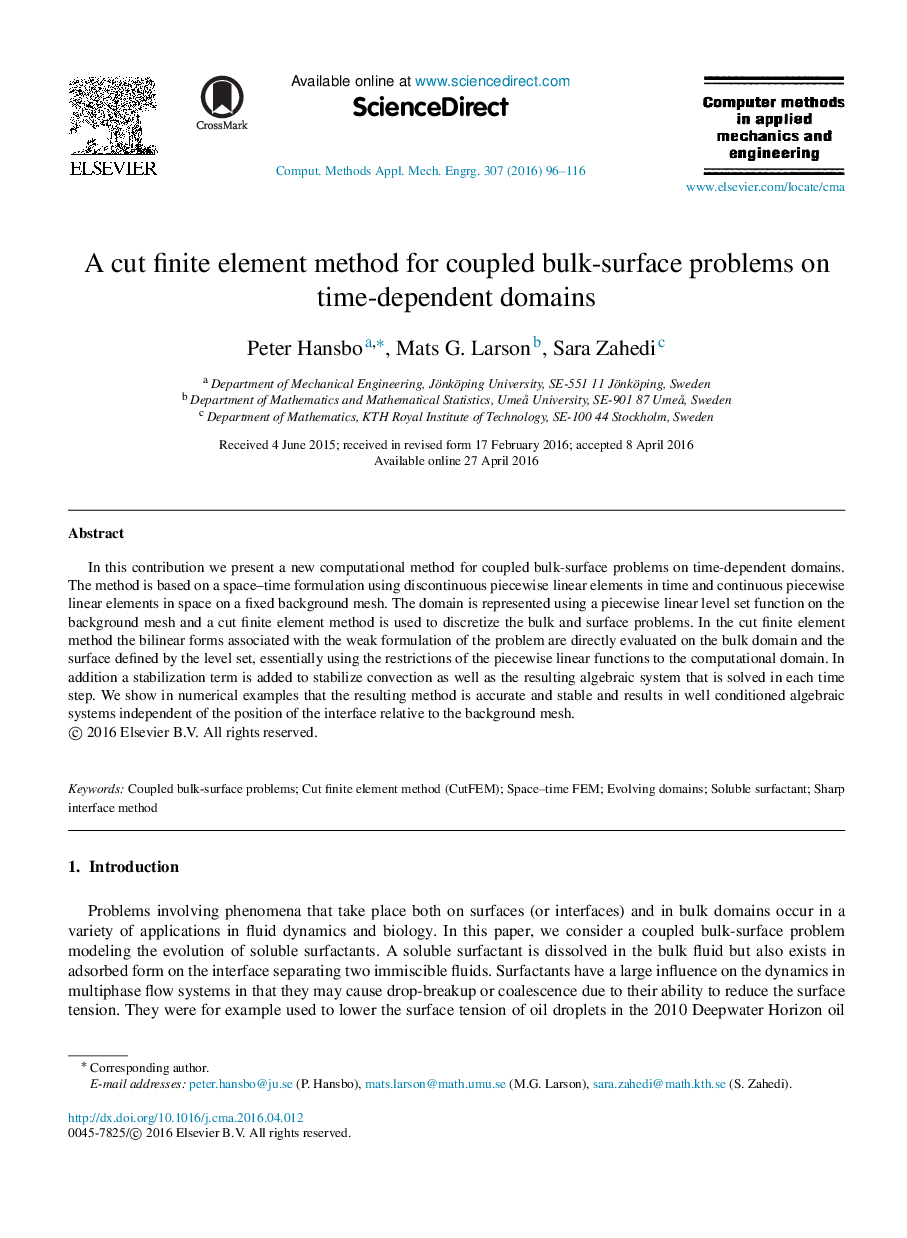| کد مقاله | کد نشریه | سال انتشار | مقاله انگلیسی | نسخه تمام متن |
|---|---|---|---|---|
| 6916043 | 862935 | 2016 | 21 صفحه PDF | دانلود رایگان |
عنوان انگلیسی مقاله ISI
A cut finite element method for coupled bulk-surface problems on time-dependent domains
ترجمه فارسی عنوان
یک روش عنصر محدود برش برای مسائل مربوط به سطح سطحی در دامنه های وابسته به زمان
دانلود مقاله + سفارش ترجمه
دانلود مقاله ISI انگلیسی
رایگان برای ایرانیان
ترجمه چکیده
در این مقاله ما یک روش محاسباتی جدید برای مسائل مربوط به سطح سطحی در دامنه های وابسته به زمان ارائه می کنیم. این روش براساس فرمولبندی فضا-زمان با استفاده از عناصر خطی قطعی در زمان و عناصر خطی مستطیلی پیوسته در فضا در یک مش زمینه ثابت استوار است. این دامنه با استفاده از یک تابع مجموعه ای خطی سطح در مش پس زمینه نمایش داده شده است و یک روش عنصر محدود برش استفاده شده است تا مسائل بزرگ و سطحی را بی فایده سازد. در روش عنصر محدود، فرمهای بیلیار در ارتباط با فرمول ضعیف مشکل، به طور مستقیم در دامنه فله و سطح تعریف شده توسط سطح تعیین شده، اساسا با استفاده از محدودیت های عملکردهای خطی قطعی به دامنه محاسباتی، به طور مستقیم ارزیابی می شود. علاوه بر این، اصطلاح تثبیت شده برای ایجاد ثبات در کنجکاوی و همچنین سیستم جبری حاصل شده است که در هر گام زمانی حل شده است. در نمونه های عددی نشان داده شده است که روش حاصل دقیق و پایدار است و نتایج سیستم های جبری را مستقل از موقعیت رابط نسبت به مش با پس زمینه نشان می دهد.
موضوعات مرتبط
مهندسی و علوم پایه
مهندسی کامپیوتر
نرم افزارهای علوم کامپیوتر
چکیده انگلیسی
In this contribution we present a new computational method for coupled bulk-surface problems on time-dependent domains. The method is based on a space-time formulation using discontinuous piecewise linear elements in time and continuous piecewise linear elements in space on a fixed background mesh. The domain is represented using a piecewise linear level set function on the background mesh and a cut finite element method is used to discretize the bulk and surface problems. In the cut finite element method the bilinear forms associated with the weak formulation of the problem are directly evaluated on the bulk domain and the surface defined by the level set, essentially using the restrictions of the piecewise linear functions to the computational domain. In addition a stabilization term is added to stabilize convection as well as the resulting algebraic system that is solved in each time step. We show in numerical examples that the resulting method is accurate and stable and results in well conditioned algebraic systems independent of the position of the interface relative to the background mesh.
ناشر
Database: Elsevier - ScienceDirect (ساینس دایرکت)
Journal: Computer Methods in Applied Mechanics and Engineering - Volume 307, 1 August 2016, Pages 96-116
Journal: Computer Methods in Applied Mechanics and Engineering - Volume 307, 1 August 2016, Pages 96-116
نویسندگان
Peter Hansbo, Mats G. Larson, Sara Zahedi,
